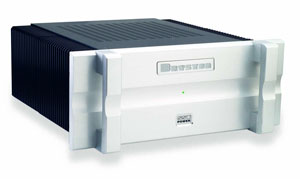 |
|||||||
| |
|
|
|
 |
|
|
|
Appearance The Sound When Tanner left, I began my customary testing routine. I had three preamps on hand, our in-house Wyetech Labs Opal (reviewed in Vol. 10, No.2), the Sim Audio P-8 and the ModWright Instruments SWL 9.0SE (both reviewed in this issue). I rotated them in and out of the system and each preamplifier allowed a clear insight into the Bryston's performance. The Opal/Bryston and P-8/Bryston combinations proved to be more revealing, to be sure, than the ModWright/Bryston pairing, but I'd have to admit that the sound of the latter combo was a touch more musically pleasing. I don't mean that it was better, just different, and very pleasing to the ears. With the Opal, bass was 100% resolute, right down to pedal-note territory, while with the ModWright, bass was less firm, but still defined enough to reveal the Brystons control. Both preamps confirmed the 28B-SST's midbass veracity that's the region from about 40Hz to 90Hz. Plucked or strummed bass, electric or upright, sounded wonderfully real; the combination readily conveyed, for example, the size and body of a traditional upright bass. The 28B-SST's midrange reproduction from about 170Hz to 1300Hz has to be an industry first among powerful solid-state designs. Instruments performing in this region did not sound even remotely close to what a typical solid-state design produces. With the Bryston, the smoothness and bloom reminded me of what I hear from a good single-ended vacuum tube amp. This may not be to everyone's liking, but I enjoyed the Bryston's brawn at the bass seamlessly coupling with the smoothness in the midrange, the region where male and female voices and many instruments perform. The only frequency range in which reproduction wasn't as smooth as one would get from a really great single-ended amp, was between about 12kHz and 20kHz. While the 28B-SSTs provided just enough smoothness to make a noticeable difference (compared to the 7B-SST, for example), they didn't wrap up with tube-like sweetness. However, most single-ended amps do not finish top and bottom frequencies entirely without imperfections. Those who want the aforementioned sweetness can attain it with the ModWright preamplifier, as I did during my listening tests. What you can expect from this combination is well-controlled bass, a blossoming midrange and sweet top-end frequencies. You should also know that these Bryston monoblocks provide resolution with unwavering proficiency. This simply means that the sound reproduction permits listeners to discern and understand the musical lines and instruments making up a performance. Of course, most preamplifiers add their own individual personality, and while the three I used clearly demonstrated the Brystons sonic attributes, I'd personally opt for the more neutral- sounding Sim Audio P-8 or the Wyetech Opal, if money were no object. Imaging can be best described as the accuracy with which an amplifier, or more precisely, a system, re-creates the original arrangement of instruments, their size and location on a sound stage. Clearly, the 28B-SST contributes to imaging, but so does the source/preamp and speaker combination. The loudspeakers I used for this evaluation come in at different price points, though it must be said that each of them is of top quality. I began with the WLM Divas, continued with the Monitor Audio GS60s and the Coincident Technology Total Victory IIIs (all reviewed in this issue) and finally, because they were on hand, I connected the WLM Gran Violas (reviewed in Vol. 16, No. 4). As revealed by the various preamp/speaker combinations I threw into the mix, an impressive sound stage with clearly defined borders can be attributed to the Bryston amps. All speakers sounded good with the Bryston amps, offering synergy and revealing the amplifiers superb sonic imprint. To find out more about the sound of the loudspeakers themselves, please read the reviews, which will help you to make better decisions about each product. Synopsis & Commentary I had expected to hear/see a really good amplifier, based on my earlier reviews of the Bryston 7B-SST and 14B-SST, but I hadn't expected to hear a pair of 1000 watt amplifiers exhibit the kind of sonic sophistication found chiefly among expensive low-powered amps. If you have a power-hungry pair of speakers, the 28B- SSTs will make them sing, but don't let that opinion hold you back if you prefer very efficient speakers. My tests clearly show that loads of power prevents amplifiers from labouring or clipping. The 28B-SST has enough power and, chances are, you will never use all of it which can be a good thing indeed.
|
|
| News | Reviews | Commentary | Marketplace | Contact Us | Home |
